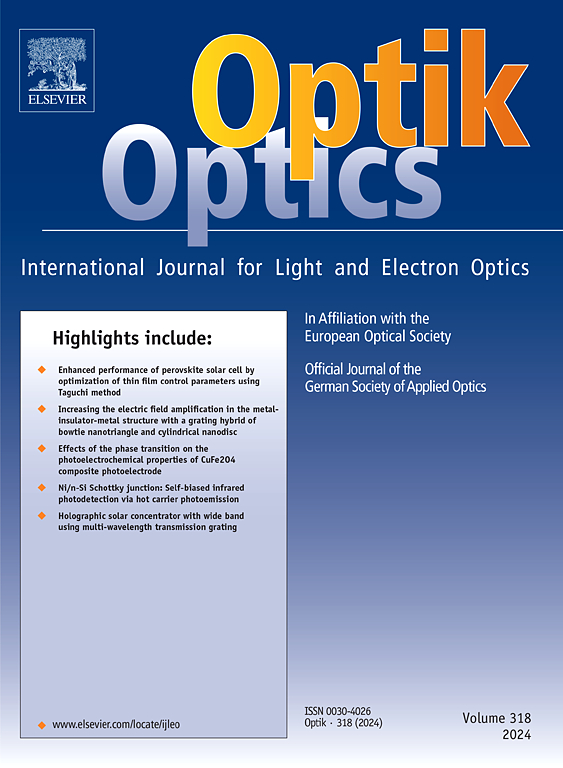TiO2-FG-based plasmonic sensor with enhanced figure of merit for sensing applications: A numerical approach
IF 3.1
3区 物理与天体物理
Q2 Engineering
引用次数: 0
Abstract
A refractive index-based surface plasmon resonance sensor using a multilayer heterostructure in the Kretschmann configuration is proposed for the near-infrared region. In the proposed configuration, aluminum is used as a plasmonic metal, titanium dioxide is used as a dielectric layer, and a fluorinated graphene (FG) layer is used as a 2D nanomaterial to enhance the performance parameters. A thorough comparative study is conducted between popularly used titanium compounds: Titanium dioxide (TiO2) and Titanium disilicide (TiSi2). For the proposed SPR sensor, each layer is engineered and optimized on the grounds of linewidth, detection accuracy (DA), and Figure of Merit (FOM), which are the critical performance parameters. To this end, the geometrical parameters are calculated using the transfer matrix method and analyzed meticulously to find the optimum trade-off points. The proposed sensor is numerically tested efficiently to sense different concentrations of hemoglobin in human blood. For the angle interrogation technique at the wavelength of 1550 nm, the sensor provides an enhanced FOM of 462.8 RIU−1 and a DA of 4 degrees−1. Thus, the proposed design opens a broader window for bio-sensing applications because of the advantages TiO2 and FG layers offer in enhancing the sensing parameters.
基于二氧化钛-石墨烯的等离子体传感器,具有增强的性能图,用于传感应用:数值方法
提出了一种基于折射率的表面等离子体共振传感器,该传感器采用克雷茨曼结构的多层异质结构,用于近红外区域。在提议的配置中,铝被用作等离子体金属,二氧化钛被用作介电层,氟化石墨烯(FG)层被用作二维纳米材料,以增强性能参数。对常用的钛化合物二氧化钛(TiO2)和二硅化钛(TiSi2)进行了深入的比较研究。对于所提出的SPR传感器,基于线宽、检测精度(DA)和优值图(FOM)这些关键性能参数,对每层进行了设计和优化。为此,采用传递矩阵法对几何参数进行了计算,并进行了细致的分析,找到了最优的权衡点。该传感器在人体血液中检测不同浓度的血红蛋白方面进行了有效的数值测试。对于1550 nm波长的角度询问技术,传感器提供了462.8 RIU−1的增强FOM和4度−1的DA。因此,由于TiO2和FG层在增强传感参数方面的优势,所提出的设计为生物传感应用打开了更广阔的窗口。
本文章由计算机程序翻译,如有差异,请以英文原文为准。
求助全文
约1分钟内获得全文
求助全文
来源期刊

Optik
物理-光学
CiteScore
6.90
自引率
12.90%
发文量
1471
审稿时长
46 days
期刊介绍:
Optik publishes articles on all subjects related to light and electron optics and offers a survey on the state of research and technical development within the following fields:
Optics:
-Optics design, geometrical and beam optics, wave optics-
Optical and micro-optical components, diffractive optics, devices and systems-
Photoelectric and optoelectronic devices-
Optical properties of materials, nonlinear optics, wave propagation and transmission in homogeneous and inhomogeneous materials-
Information optics, image formation and processing, holographic techniques, microscopes and spectrometer techniques, and image analysis-
Optical testing and measuring techniques-
Optical communication and computing-
Physiological optics-
As well as other related topics.
 求助内容:
求助内容: 应助结果提醒方式:
应助结果提醒方式:


